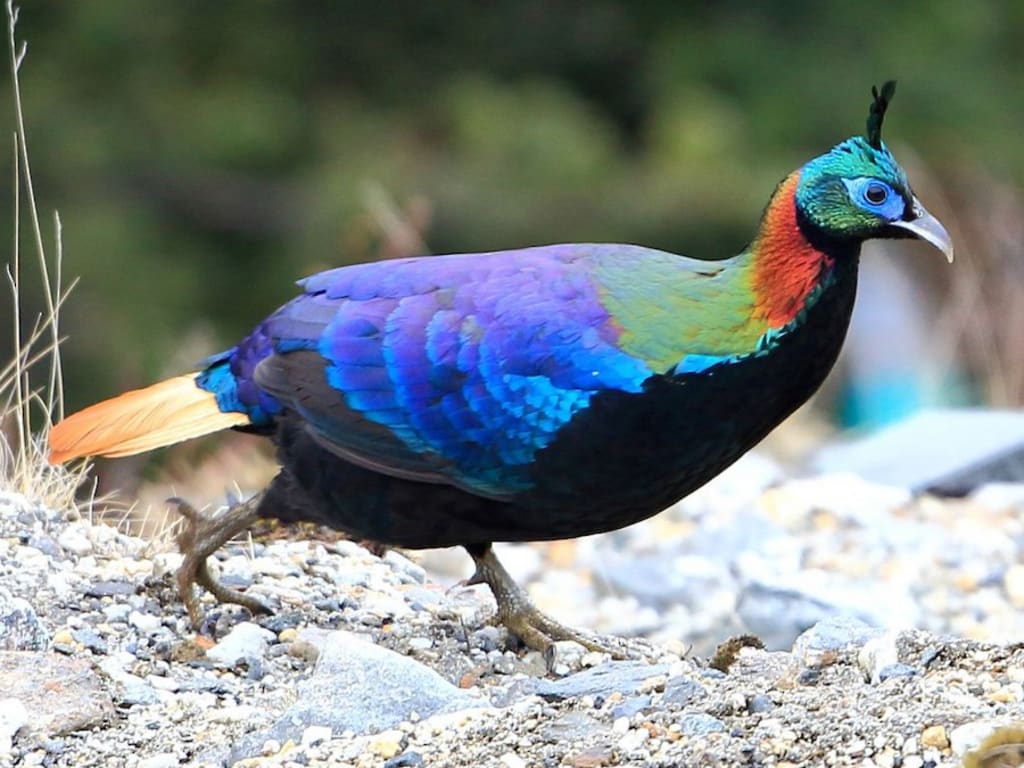
The Himalayan region is home to the wonderfully colored Himalayan Monal (Lophophorus impejanus). Here are some specifics regarding this stunning bird:
Look:
The iridescent, multicolored plumage of males is very vivid, with colors of green, blue, red, and gold.
In order to better blend in, females are primarily brown and less colorful.
Habitat:
found in the Himalayan high-altitude mixed and coniferous woods, typically at elevations of 9,800 to 15,000 feet.
Range:
indigenous to the Himalayan region, which includes portions of Tibet, India, Nepal, and Bhutan.
Nutrition:
primarily herbivorous, consuming a range of seeds, insects, and plant materials for sustenance.The paraphrasing tool provided by QuillBot can assist you in rapidly and effectively reworking and rephrasing your sentences!
Action:
In order to entice females, males are renowned for their intricate courtship displays that highlight their vivid plumage.
usually reticent and elusive, staying mostly in deep woodlands.
Status of Conservation:
Though certain populations are threatened by habitat loss and hunting, the species is listed as "Least Concern" on the IUCN Red List.
Because of its remarkable colors and distinct habits, seeing the Himalayan Monal is an unforgettable experience.
Of course! Here are some further specifics regarding the Himalayan Monal:
Feeding Patterns:
Berries, leaves, and roots are among the many types of plants that make up the diet. They eat larvae and insects as well.
Particular Iridescence:
Males have bright plumage because the feathers contain minute platelets that refract light to create a beautiful iridescence.
Unique Tail:
The long, graduated tail of both males and females, which features iridescent "racket" feathers at the end, adds to their overall regal aspect.
Adaptations for High Altitudes:
Their feathering acts as insulation against the cold, helping them to adapt well to the harsh circumstances of high-altitude habitats.
Changes in Color and Molt:
After the breeding season, males molt, temporarily losing their vivid colors and taking on a more cryptic look.
Symbolism within Culture:
The Himalayan Monal is frequently connected to spiritual and cultural significance in local folklore and customs, signifying harmony and beauty in the natural world.
Features of Flight:
The Himalayan Monals are nimble flyers who can easily maneuver through the deep jungles, despite their size.
The role of ecology
As herbivores, they aid in the spread of seeds and preserve the ecosystem's equilibrium in the forest.
Photographic Interest:
Photographers of nature and birdwatchers alike are drawn to the Himalayan Monal because of its distinctive features and colorful plumage.
Of course, these are some more facts regarding the Himalayan Monal:
Organic Disguise:
When nesting, female Himalayan Monals may effectively blend into the forest floor thanks to their cryptic dark coloring.
Matrimonial Customs:
Males show their bright feathers, bob their heads, and make different calls in an attempt to entice females during courtship displays. Observing these intricate routines is a show.
Range of Elevations:
Found at a variety of heights, demonstrating their tolerance to a range of climatic circumstances, from lower hills to alpine meadows.
Family Relationships:
Families tend to stick together, with parents and kids creating strong social groupings. Predator protection is aided by this social framework.
Sites for Nesting:
Usually, nests are constructed in well-hidden spots on the ground to keep predators out of sight. When building and tending to the nest, the female assumes the lead role.
Avoiding Predators:
In order to recognize and avoid predators, the Himalayan Monal has developed vigilant behaviors. They are less susceptible to dangers because of their acute senses and quick takeoff.
Human Communication:
They now forage in fields and close to populated areas in some places where they have acclimated to human presence. They may be exposed to some risks as a result, though.
Durability:
The typical lifespan of a Himalayan monal in the wild is five to seven years, though this might vary depending on predation and environmental factors.
Conservation Difficulties:
Even though they are presently considered to be in "Least Concern," continued habitat loss, climate change, and hunting could endanger their numbers, which makes conservation activities even more important.
The behavior, ecology, and relationships of the Himalayan Monal in its various habitats are better understood because to these subtle features.
About the Creator
Aadhya_love_0710
Living the dream;
Keep it real;
Less is more;
Smile, it's free;
Simplicity is the key to happiness...






Comments (2)
Great job
amazing information .....